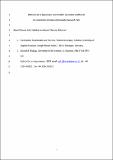Effective use of Spearman's and Kendall's correlation coefficients for association between two measured traits
Abstract
We examine the performance of the two rank order correlation coefficients (Spearman's rho and Kendall's tau) for describing the strength of association between two continuously measured traits. We begin by discussing when these measures should, and should not, be preferred over Pearson's product-moment correlation coefficient on conceptual grounds. For testing the null hypothesis of no monotonic association, our simulation studies found both rank coefficients show similar performance to variants of the Pearson product-moment measure of association, and provide only slightly better performance than Pearson's measure even if the two measured traits are non-normally distributed. Where variants of the Pearson measure are not appropriate, there was no strong reason (based on our results) to select either of our rank-based alternatives over the other for testing the null hypothesis of no monotonic association. Further, our simulation studies indicated that for both rank coefficients there exists at least one method for calculating confidence intervals that supplies results close to the desired level if there are no tied values in the data. In this case, Kendall's coefficient produces consistently narrower confidence intervals, and might thus be preferred on that basis. However, if there are any ties in the data, irrespective of whether the percentage of ties is small or large, Spearman's measure returns values closer to the desired coverage rates, whereas Kendall's results differ more and more from the desired level as the number of ties increases, especially for large correlation values.
Citation
Puth , M-T , Neuhäuser , M & Ruxton , G D 2015 , ' Effective use of Spearman's and Kendall's correlation coefficients for association between two measured traits ' , Animal Behaviour , vol. 102 , pp. 77-84 . https://doi.org/10.1016/j.anbehav.2015.01.010
Publication
Animal Behaviour
Status
Peer reviewed
ISSN
0003-3472Type
Journal article
Collections
Items in the St Andrews Research Repository are protected by copyright, with all rights reserved, unless otherwise indicated.

